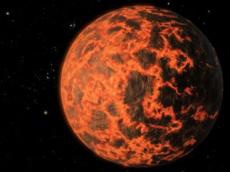|
|
TODAY.AZ / Weird / Interesting
Planet smaller than earth discovered
21 July 2012 [12:08] - TODAY.AZ
 Thirty-three light-years away, in the constellation Leo the lion, astronomers say they have found a world considerably smaller than Earth, orbiting a dim red-dwarf star.
Thirty-three light-years away, in the constellation Leo the lion, astronomers say they have found a world considerably smaller than Earth, orbiting a dim red-dwarf star.That's something to think about. While scientists have confirmed the existence of more than 700 so-called exoplanets since 1995, most of them have been giant -- many considerably larger than Jupiter. This new world, say the researchers who found it, may be only 5,200 miles across, about two thirds as large as Earth.
"People have been picking at the low-hanging fruit, since Jupiter-sized planets are easier to see," said Kevin Stevenson, the young researcher at the University of Central Florida who led the team making the find. "Now we're really pushing the limits of what our telescopes can find."
The newly found world is, for now, called UCF-1.01, and Stevenson and his colleagues found it with NASA's Spitzer space telescope in Earth orbit. It orbits a star called GJ 436. They spent a year watching it to confirm that it was indeed a distant world. They are publishing their find online Thursday in the Astrophysical Journal.
UCF-1.01 is probably not a very nice place. Stevenson and his group calculated that it whips around its host star in only 1.4 Earth-days, at a distance of about 1.6 million miles (we're 93 million miles from our sun). Temperatures on its surface probably exceed 1,000 degrees Fahrenheit, raising the possibility that some of it is molten, covered in lava. Any atmosphere would have boiled away long ago, said the researchers.
They could not see it directly -- its sun is nothing but a dot in a telescope -- but they could see a tiny dip in the star's brightness as the disc of UCF-1.01 passed in front of it. For now, they cannot even calculate its mass; current technology is not good enough for a reliable number.
Nobody will be launching a mission to UCF-1.01 anytime soon; there are other worlds, including moons of Jupiter and Saturn, that look much more promising as homes for living things. Still, the find suggests that if this world could be detected, others -- perhaps in the so-called habitable zones around their host stars -- may soon be found as well.
"The discovery was completely by accident," said Stevenson in a telephone interview with ABC News. They were looking at another, much larger planet orbiting the same star, "and there were these spurious signals we could not explain."
/Yahoo/
URL: http://www.today.az/news/interesting/110669.html
 Print version
Print version
Views: 2096
Connect with us. Get latest news and updates.
See Also
- 06 December 2024 [22:20]
Are scented candles harmful to health? - 23 November 2024 [14:11]
Magnitude 4.5 earthquake hits Azerbaijan's Lachin - 20 November 2024 [23:30]
Launch vehicle with prototype of Starship made its sixth test flight - 27 October 2024 [09:00]
Fuel prices expected to rise in Sweden - 24 October 2024 [19:14]
Turkiye strikes terror targets in Iraq and Syria - 23 October 2024 [23:46]
Kazakhstan supplied almost entire volume of oil planned for 2024 to Germany in 9 months - 23 October 2024 [22:17]
Taiwan reported passage of Chinese Navy aircraft carrier near island - 23 October 2024 [21:50]
Russia remains largest oil supplier to India - 16 October 2024 [17:54]
Gamesummit co-founder shares insights on future of gaming industry in Azerbaijan [EXCLUSIVE] - 12 October 2024 [18:27]
TikTok cuts jobs, turns to AI for content moderation
Most Popular
 Pashinyan plants a pig for the Armenians
Pashinyan plants a pig for the Armenians
 Changing global geopolitics & implications for Pakistan
Changing global geopolitics & implications for Pakistan
 U.S. finalizes US$4.7 bln in CHIPS Act subsidy to Samsung Electronics
U.S. finalizes US$4.7 bln in CHIPS Act subsidy to Samsung Electronics
 Turkish FM meets Syrian leader in post-Assad era
Turkish FM meets Syrian leader in post-Assad era
 Gloveman: Macron and his one-time premieres
Gloveman: Macron and his one-time premieres
 New Zealand rejects plan to introduce its own passports for residents of Cook Islands
New Zealand rejects plan to introduce its own passports for residents of Cook Islands
 Azerbaijani ambassador discusses climate cooperation with Iranian officials
Azerbaijani ambassador discusses climate cooperation with Iranian officials
